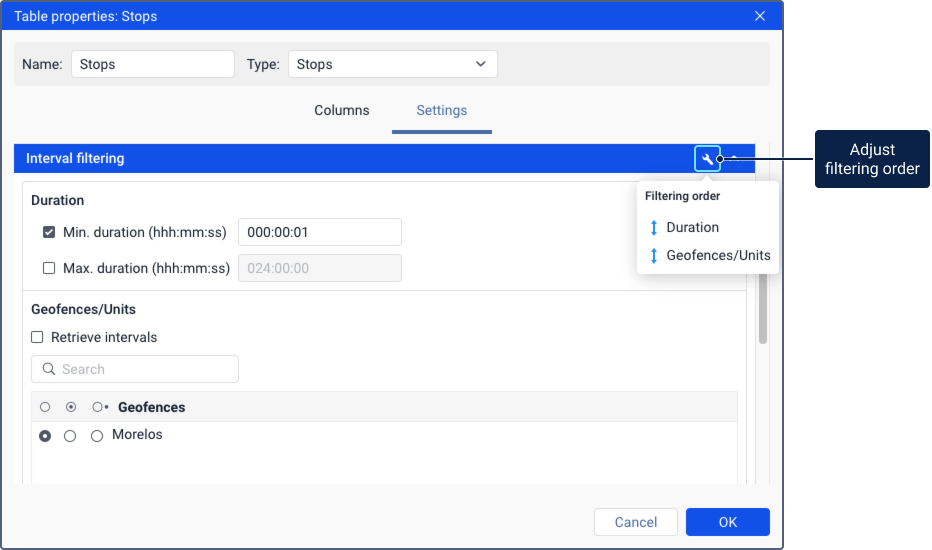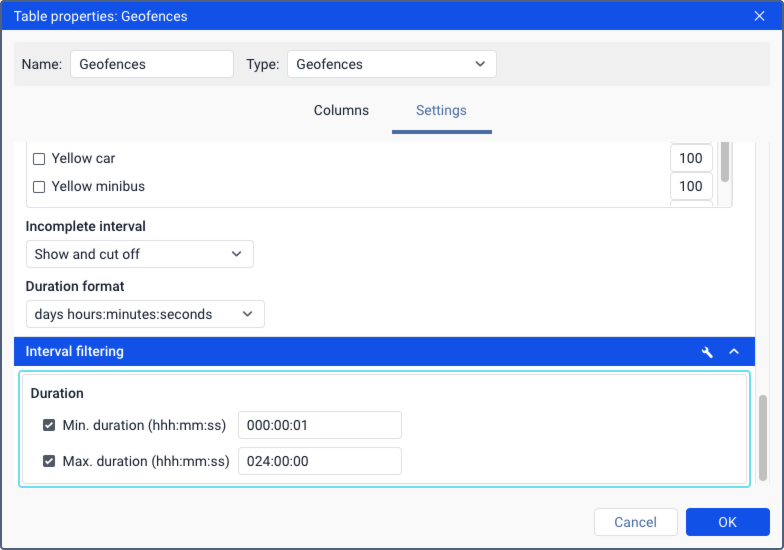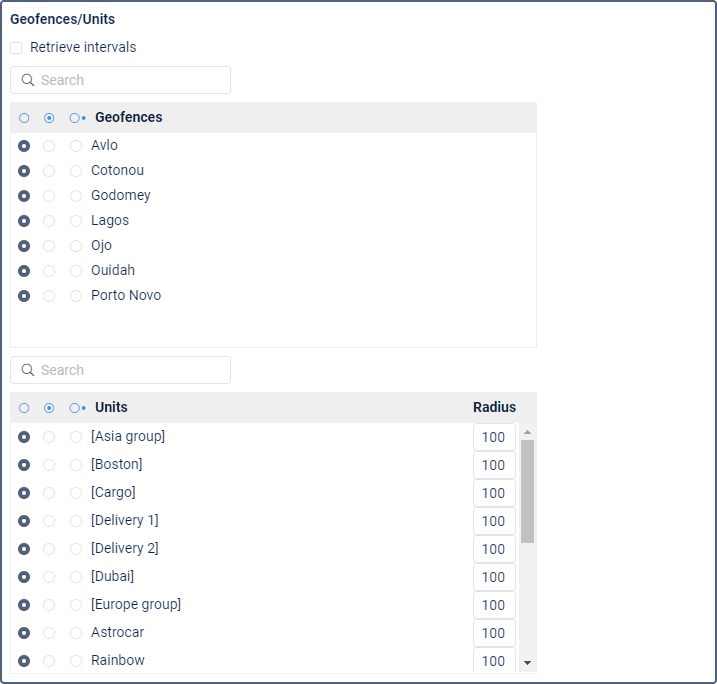Interval Filtration
When executing most tabular reports in the system, time intervals corresponding to the table type are retrieved from the unit history. For example, the intervals refer to the unit trips in a report on trips, while in a report on geofences, the intervals refer to the unit being within a geofence. You can apply filtration to these intervals on the basis of certain parameters. For example, the report can show only those trips that lasted longer than the specified time, or only those geofence visits during which the vehicle was parked.
You can see the Interval filtration section on the Settings tab of the table properties. The available filters, that is, the parameters on the basis of which filtration is carried out, depend on the table type.

You can apply several filters simultaneously. To change the order in which the filters are applied, click on the icon  and drag the list items above or below.
and drag the list items above or below.
All filters except for the mileage filter work only with integer values.
All the possible filters are described in detail below.
Custom sensor masks
In this filter, you can specify the masks of custom sensors which should be taken into account when running the report. The filter is available in the Geofences table.

Custom sensor name
The filter allows you to specify the name of a custom sensor, the value of which can be displayed in the Geofences table in the unit group report in following report columns:
- Avg value of custom sensor;
- Min. value of custom sensor;
- Max. value of custom sensor;
- Final value of custom sensor.
In the Custom sensor name field, specify the full name of the custom sensor the value of which you want to see in the report. To specify the names of several sensors, click Add custom sensor name.

Driver
Not applicable in the system.
Duration
This filter consists of the Min duration and Max duration fields where you can specify the minimum and maximum duration of the intervals to be shown in the report. The maximum allowed value for this filter is 999 h 59 min 59 s (about 41 days and 16 hours).

Example. A value of 10 minutes is indicated in the Min duration field. A report on trips is executed. All the trips lasting 10 minutes or more will be included in the report.
Engine hours
Here in the Min engine hours and Max engine hors fields, you can specify the minimum and/or maximum duration of engine hours required for the interval to be included in the report. The maximum allowed value for this filter is 99 h 59 min 59 s (about 4 days and 4 hours).

The duration of the engine hours is determined by the sensor of engine hours. You can specify its name or mask in the Engine hours sensor filter.
Engine hours sensor
In this filter, you can specify a name mask for the engine hours sensor in the Name mask field. The mask is used for the Initial engine hours and Final engine hours columns of the Geofences table, and for the Engine hours filter, if this filter is enabled.

Geofences/Units
The filter allows you to see those intervals within which the unit was inside or outside of the selected geofence or area around the selected unit.
By default, the intervals are shown entirely. To see only those parts of the interval during which the unit was inside or outside of the geofence/unit area, enable the Retrieve intervals option.
When determining the time at which the unit crossed geofences or unit areas, the Maximum interval between messages option from the unit properties is taken into account.
The filter section consists of two lists: the list of geofences and the list of units. Above each list, there is a dynamic search by item name.

For each list item, you can specify one of three statuses:
 : not to take the item into account;
: not to take the item into account; : display the intervals within which the unit was inside this geofence or unit area;
: display the intervals within which the unit was inside this geofence or unit area; : display the intervals within which the unit was outside this geofence or unit area;
: display the intervals within which the unit was outside this geofence or unit area;
For units, you can specify the radius of the area around them, that is, how close the unit on which the report is executed should be to these units in order for the interval to be included in the report.
To select all the items in the list, hold Ctrl while selecting them. If a group is marked, then all the units from the group are considered selected. In this case, an interval is shown in the report if any of these unit areas were visited during it.
If the set of units in the selected group changes after creating the report template, then these changes are taken into account at the time of the report execution.
Mileage
Here in the Min mileage and Max mileage fields, you can specify the maximum and/or minimum mileage required for the interval to be included in the report. Fractional values are allowed, with a point as a separator.

Parkings
The filter allows you to see only those intervals withing which parking periods were detected (With parkings option), or only those intervals within which there were no parking periods (Without parkings option). Parking periods are detected according to the settings in the trip detector. See the detailed description here.

If the With parkings option is selected, you can specify the minimum parking duration in the Min duration field in order for the interval to be included in the report. If the Sum up intervals option is enabled, the duration of all the parking periods within the interval is summed up and compared with the specified minimum duration.
Example. A report on geofence visits is executed. You want the report to show only the visits during which the unit was parked. A value of 10 min. is specified in the Min duration field. The unit had been parked inside the geofence for 5 and for 7 minutes. If the Sum up intervals option is disabled, the geofence visit won’t be included in the report. If the option is enabled, the visit will be shown in the report because the total parking duration was 12 minutes and the minimum duration requirement was met.
Sensors
This filter allows you to see the intervals within which a digital sensor was on or off.

The following options are available for the filter:
| Option | Description |
|---|---|
| With sensor on | The report shows the intervals within which the sensor was on. By default, the intervals in the report are displayed entirely. To see only those parts of the interval during which the sensor was on, activate the Retrieve intervals option. In the Sensor masks filter, you can specify the name of a sensor or a mask for several sensors. If several sensors are specified, the report shows the intervals within which all of them were on at the same time. If no sensor is specified, all the unit sensors are taken into account in the report. |
| With sensor off | The report shows the intervals within which the sensor was off. For this option, you can also retrieve intervals and specify a sensor mask (see the description above). |
| Min duration | The minimum time during which the sensor should be on or off in order for the interval to be shown in the report. |
| Max duration | The maximum time within which the sensor should be on or off in order for the interval to be shown in the report. This option is used if you don't want the report to take into account the sensors that are on for a long time. |
| Retrieve intervals | If the option is disabled, the intervals in the report are shown entirely when they match the filter conditions. If the option is enabled, then the report shows only those parts of the interval during which the sensor was on or off. Each such part occupies a separate line. |
| Sum up intervals | This option can only be used if the Min duration and/or Max duration fields are filled in. If it is enabled, then all the periods during which the sensor was on or off within the report interval are summed up and the result is compared with the specified duration value. If the amount matches the condition, the interval is shown in the report. Example. A report on trips with the sensor on is executed. A value of 60 seconds is indicated in the Min duration field. The Sum up intervals option is activated. During the trip, the sensor was on for 20 seconds, for 30 seconds and for 15 seconds, that is, for a total of 65 seconds. This value meets the minimum duration condition, therefore, the trip is shown in the report. |
Sensor masks
Here you can specify the masks of the sensors which should be taken into account when executing the report. The specified masks influence:
- Sensors filter;
- values in the Counter, Initial counter, Final counter columns;
- custom sensor values if the Custom sensor masks filter is not used.

The mask of the engine hours sensor is specified separately in the Engine hours sensor filter.
Speed range
Here in the Min speed and Max speed fields, you can the minimum and/or maximum unit speed required for the interval to be included in the report.

If you want the report to show only those periods during which the speed met the specified conditions, activate the Retrieve intervals option.
Stops
The following options are available in the filter:
| Option | Description |
|---|---|
| With stops | The report shows intervals within which stops were detected. |
| Without stops | The report shows intervals within which no stops were detected. |

The intervals themselves are shown entirely.
Trailer
Not applicable in the system.
Trips
The following options are available in the filter:
| Option | Description |
|---|---|
| With trips | The report shows intervals within which a unit trip was detected, even if only a part of it is included in the interval. |
| Without trips | The report shows intervals within which no trips were detected. |
The system detects trips in accordance with the parameters specified on the Trip detector tab of the unit properties.

Example. You execute a report on geofence visits and want the system to ignore the false coordinates sent by the unit while parked, so that the visit is not divided into several visits. For this purpose, enable the Trips filter and select the With trips option.